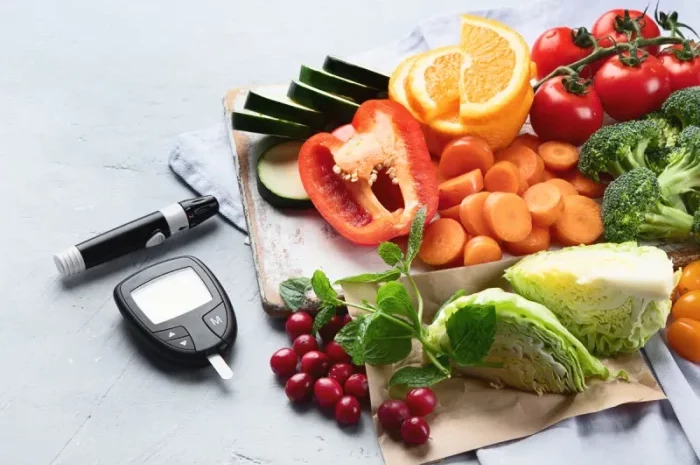Diabetes is a chronic condition that affects millions of people worldwide. Managing diabetes effectively involves a combination of medication, physical activity, and dietary modifications. Among the dietary changes, the inclusion of fruits and vegetables is paramount. These food groups provide essential nutrients, help regulate blood sugar levels, and contribute to overall health. This article delves into the reasons why consuming vegetables and fruits is crucial for individuals with diabetes, supported by scientific evidence and practical advice.
Nutritional Benefits of Vegetables and Fruits
Vegetables and fruits are rich in vitamins, minerals, fiber, and antioxidants, all of which are essential for maintaining good health. For individuals with diabetes, these nutrients play a crucial role in managing blood sugar levels and preventing complications.
Vitamins and Minerals
Fruits and vegetables are excellent sources of vitamins A, C, and E, as well as minerals like potassium, magnesium, and calcium. These micronutrients are vital for various bodily functions, including immune response, bone health, and cardiovascular function. For example, vitamin C, found in citrus fruits, strawberries, and bell peppers, helps improve immune function and reduce inflammation, which is beneficial for individuals with diabetes who are at higher risk of infections and inflammation.
Dietary Fiber
One of the key components of vegetables and fruits that aids in diabetes management is dietary fiber. Fiber slows down the digestion and absorption of carbohydrates, leading to a more gradual rise in blood sugar levels. This can help prevent spikes and crashes in blood glucose, making it easier to maintain stable levels. Foods high in fiber include leafy greens, berries, apples, and carrots. The American Diabetes Association recommends consuming at least 14 grams of fiber per 1,000 calories, which translates to about 25 grams for women and 38 grams for men per day.
Antioxidants
Antioxidants are compounds that help neutralize free radicals, which can cause oxidative stress and damage cells. This oxidative stress is linked to the development of diabetes complications, such as cardiovascular disease, neuropathy, and retinopathy. Fruits and vegetables are rich in antioxidants like flavonoids, carotenoids, and polyphenols. For instance, berries are packed with anthocyanins, which have been shown to improve insulin sensitivity and reduce inflammation.
Glycemic Index and Glycemic Load
Understanding the glycemic index (GI) and glycemic load (GL) of foods is crucial for diabetes management. The GI measures how quickly a carbohydrate-containing food raises blood glucose levels, while the GL takes into account both the GI and the carbohydrate content of the food.
Low-GI Foods
Most vegetables and many fruits have a low GI, meaning they cause a slow, steady rise in blood sugar. Examples of low-GI vegetables include leafy greens, broccoli, and cauliflower. Fruits such as apples, pears, and berries also have a low GI. Including these foods in the diet can help maintain stable blood sugar levels and reduce the risk of hyperglycemia.
Balancing High-GI Foods
While some fruits, like watermelon and pineapple, have a higher GI, they can still be part of a balanced diet when eaten in moderation and combined with low-GI foods. For example, pairing a high-GI fruit with a source of protein or healthy fat can help lower the overall glycemic impact of the meal.
Weight Management and Satiety
Maintaining a healthy weight is crucial for managing diabetes, as excess body weight can lead to insulin resistance. Vegetables and fruits are low in calories and high in water and fiber, making them an excellent choice for weight management. They help increase satiety, which can reduce overall calorie intake and aid in weight loss or maintenance.
Caloric Density
The concept of caloric density refers to the number of calories in a given volume of food. Vegetables and fruits have low caloric density, meaning they provide fewer calories per gram compared to other foods. This allows individuals to eat larger portions without consuming too many calories, which is beneficial for weight control.
Satiety and Appetite Control
Fiber-rich foods like vegetables and fruits help increase feelings of fullness and reduce hunger. This can prevent overeating and snacking on unhealthy foods, which is important for maintaining stable blood sugar levels. Including a variety of vegetables and fruits in meals and snacks can help control appetite and support weight management efforts.
Blood Pressure and Cardiovascular Health
Individuals with diabetes are at a higher risk of developing cardiovascular diseases, such as hypertension, heart attack, and stroke. Consuming vegetables and fruits can help mitigate these risks by supporting cardiovascular health.
Potassium and Blood Pressure
Many vegetables and fruits are rich in potassium, a mineral that helps regulate blood pressure. Potassium counteracts the effects of sodium, reducing tension in blood vessel walls and lowering blood pressure. Foods high in potassium include bananas, sweet potatoes, spinach, and avocados. Consuming these foods can help manage hypertension, a common comorbidity in diabetes.
Fiber and Cholesterol Levels
Soluble fiber, found in fruits like apples, pears, and citrus fruits, helps lower LDL (bad) cholesterol levels by binding to cholesterol in the digestive system and removing it from the body. Lowering LDL cholesterol is crucial for reducing the risk of cardiovascular diseases. Incorporating a variety of fiber-rich fruits and vegetables into the diet can contribute to healthier cholesterol levels.
Antioxidants and Heart Health
Antioxidants in vegetables and fruits help protect the cardiovascular system by reducing oxidative stress and inflammation. For example, flavonoids found in berries, citrus fruits, and leafy greens have been shown to improve endothelial function and reduce the risk of heart disease. Including a wide range of colorful fruits and vegetables in the diet ensures a diverse intake of antioxidants that support heart health.
Prevention of Diabetes Complications
Diabetes can lead to various complications, including neuropathy, retinopathy, nephropathy, and infections. Consuming vegetables and fruits can help prevent or delay the onset of these complications by providing essential nutrients and promoting overall health.
Neuropathy
Neuropathy, or nerve damage, is a common complication of diabetes that can cause pain, numbness, and weakness, particularly in the extremities. Antioxidants and anti-inflammatory compounds in vegetables and fruits can help protect nerve cells from damage. For example, alpha-lipoic acid, found in spinach and broccoli, has been shown to improve symptoms of neuropathy.
Retinopathy
Diabetic retinopathy is a leading cause of blindness in individuals with diabetes. It occurs when high blood sugar levels damage the blood vessels in the retina. Consuming foods rich in antioxidants, such as leafy greens, carrots, and citrus fruits, can help protect eye health. Lutein and zeaxanthin, carotenoids found in green leafy vegetables, have been shown to reduce the risk of developing retinopathy.
Nephropathy
Diabetic nephropathy, or kidney disease, is another serious complication of diabetes. Maintaining a diet rich in vegetables and fruits can help support kidney health by providing essential nutrients and reducing inflammation. For example, berries and leafy greens contain compounds that protect kidney cells and improve kidney function.
Infections
Individuals with diabetes are more susceptible to infections due to high blood sugar levels that impair immune function. Consuming a variety of vegetables and fruits can help strengthen the immune system and reduce the risk of infections. Vitamin C, zinc, and other immune-boosting nutrients found in these foods play a vital role in maintaining a healthy immune response.
Practical Tips for Incorporating Vegetables and Fruits into the Diet
While the benefits of vegetables and fruits are clear, incorporating them into the diet can be challenging for some individuals. Here are practical tips to help make these nutritious foods a regular part of your meals and snacks.
Meal Planning and Preparation
Planning meals and snacks in advance can help ensure a consistent intake of vegetables and fruits. Consider setting aside time each week to prepare and portion out servings of fruits and vegetables. This can make it easier to grab a healthy snack or add a side of vegetables to meals.
Variety and Creativity
Eating a variety of vegetables and fruits ensures a diverse intake of nutrients and keeps meals interesting. Experiment with different cooking methods, such as roasting, grilling, steaming, or sautéing, to enhance the flavors and textures of vegetables. Adding fruits to salads, smoothies, and desserts can also increase variety and enjoyment.
Portion Control
While vegetables and fruits are healthy, portion control is still important, especially for fruits that contain natural sugars. Aim to fill half your plate with non-starchy vegetables and limit fruit servings to about one cup per meal. Pairing fruits with a source of protein or healthy fat can help balance blood sugar levels and keep you satisfied longer.
Seasonal and Local Produce
Choosing seasonal and locally grown produce can enhance the taste and nutritional value of vegetables and fruits. Seasonal produce is often fresher and more flavorful, making it more enjoyable to eat. Visiting local farmers’ markets can also provide access to a variety of fresh, high-quality produce.
Mindful Eating
Practicing mindful eating can help you appreciate the flavors, textures, and aromas of vegetables and fruits. Take time to savor each bite, and pay attention to how these foods make you feel. Mindful eating can enhance your enjoyment of healthy foods and help you develop a more positive relationship with food.
See also: Why It Is Important To Follow A Healthy Diet
Conclusion
Incorporating vegetables and fruits into the diet is essential for individuals with diabetes. These nutrient-dense foods provide vitamins, minerals, fiber, and antioxidants that support overall health, regulate blood sugar levels, and prevent complications. By understanding the benefits of vegetables and fruits and adopting practical strategies to include them in daily meals, individuals with diabetes can improve their quality of life and achieve better health outcomes.
Related topics:
The Minimum Blood Sugar Levels: A Comprehensive Guide
What’s the Importance of Including Carbohydrates in a Diabetic Diet

























